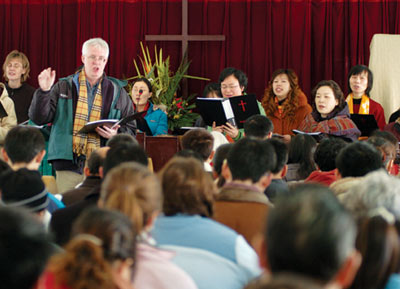|
China is a country of great religious diversity and freedom of religious belief. It has over 100 million followers of various faiths, more than 100,000 sites for religious activities, about 300,000 religious personnel and over 3,000 religious associations. These associations run 76 religious schools and colleges to train religious personnel. In China, regular religious activities — such as worshipping the Buddha, chanting scriptures, praying, expounding on scriptures, holding Mass, baptism, initiation into monk — or nun-hood, and observance of religious festivals such as Ramadan — are all managed by the religious personnel and adherents themselves, and protected by the law and free from interference. The holy books of each religion are published and distributed by religious associations. Each religion has its own national periodical, which is also circulated abroad.
The main religions are Buddhism, Islam, Roman Catholic and Protestant Christianity, China's indigenous Taoism, Shamanism, Eastern Orthodox Christianity and the Naxi people's Dongba religion. The Hui, Uygur, Kazak, Kirgiz, Tatar, Ozbek, Tajik, Dongxiang, Salar and Bonan peoples adhere to Islam; the Tibetan, Mongolian, Lhoba, Monba, Tu and Yugur, to Tibetan Buddhism (also known as Lamaism), and the Dai, Blang and De'ang to Hinayana Buddhism. Large numbers of Miao, Yao and Yi are Catholic or Protestant Christians. Religious Han Chinese tend to practice Buddhism, Christianity, Catholic or Taoism.
Buddhism was introduced to China from India around the first century, and became the most influential religion in China after the fourth century. Tibetan Buddhism, as a branch of Chinese Buddhism, is popular primarily in Tibet and Inner Mongolia. Now China has more than 13,000 Buddhist temples.
It is probable that Islam first reached China around the mid-seventh century. The Yuan Dynasty witnessed the zenith of prosperity of Islam. Now China has more than 30,000 mosques.
Catholic influence reached China in the seventh century, and Protestantism was introduced into China in the early 19th century. Now there are more than 4,600 Catholic churches and over 12,000 Protestant churches, in addition to 30,000 temporary places of worship.
Congregation of Chinese and foreign Christians, Nanjing
Taoism is based on the philosophy of Lao Zi (traditionally said to be born in 604 B.C.) and his work Dao De Jing (Classic of the Way and Virtue). It probably took shape as a religion during the second century, and China now has more than 1,500 Taoist temples.
Taoist service
|






